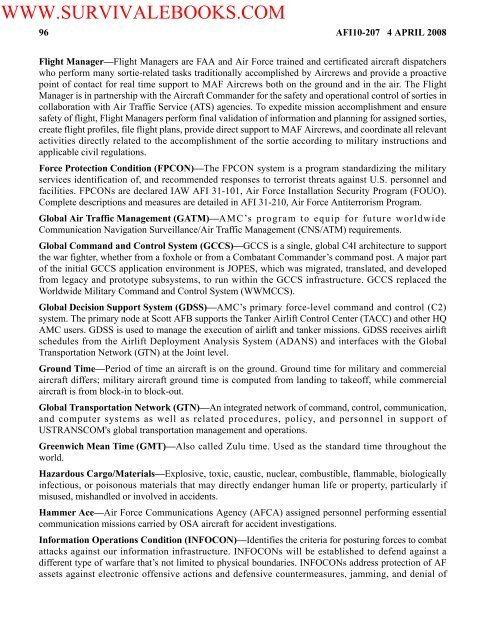2004 US Air Force OPERATIONAL REPORTING ... - Survival Books
2004 US Air Force OPERATIONAL REPORTING ... - Survival Books
2004 US Air Force OPERATIONAL REPORTING ... - Survival Books
Create successful ePaper yourself
Turn your PDF publications into a flip-book with our unique Google optimized e-Paper software.
WWW.SURVIVALEBOOKS.COM96 AFI10-207 4 APRIL 2008Flight Manager—Flight Managers are FAA and <strong>Air</strong> <strong>Force</strong> trained and certificated aircraft dispatcherswho perform many sortie-related tasks traditionally accomplished by <strong>Air</strong>crews and provide a proactivepoint of contact for real time support to MAF <strong>Air</strong>crews both on the ground and in the air. The FlightManager is in partnership with the <strong>Air</strong>craft Commander for the safety and operational control of sorties incollaboration with <strong>Air</strong> Traffic Service (ATS) agencies. To expedite mission accomplishment and ensuresafety of flight, Flight Managers perform final validation of information and planning for assigned sorties,create flight profiles, file flight plans, provide direct support to MAF <strong>Air</strong>crews, and coordinate all relevantactivities directly related to the accomplishment of the sortie according to military instructions andapplicable civil regulations.<strong>Force</strong> Protection Condition (FPCON)—The FPCON system is a program standardizing the militaryservices identification of, and recommended responses to terrorist threats against U.S. personnel andfacilities. FPCONs are declared IAW AFI 31-101, <strong>Air</strong> <strong>Force</strong> Installation Security Program (FOUO).Complete descriptions and measures are detailed in AFI 31-210, <strong>Air</strong> <strong>Force</strong> Antiterrorism Program.Global <strong>Air</strong> Traffic Management (GATM)—AMC’s program to equip for future worldwideCommunication Navigation Surveillance/<strong>Air</strong> Traffic Management (CNS/ATM) requirements.Global Command and Control System (GCCS)—GCCS is a single, global C4I architecture to supportthe war fighter, whether from a foxhole or from a Combatant Commander’s command post. A major partof the initial GCCS application environment is JOPES, which was migrated, translated, and developedfrom legacy and prototype subsystems, to run within the GCCS infrastructure. GCCS replaced theWorldwide Military Command and Control System (WWMCCS).Global Decision Support System (GDSS)—AMC’s primary force-level command and control (C2)system. The primary node at Scott AFB supports the Tanker <strong>Air</strong>lift Control Center (TACC) and other HQAMC users. GDSS is used to manage the execution of airlift and tanker missions. GDSS receives airliftschedules from the <strong>Air</strong>lift Deployment Analysis System (ADANS) and interfaces with the GlobalTransportation Network (GTN) at the Joint level.Ground Time—Period of time an aircraft is on the ground. Ground time for military and commercialaircraft differs; military aircraft ground time is computed from landing to takeoff, while commercialaircraft is from block-in to block-out.Global Transportation Network (GTN)—An integrated network of command, control, communication,and computer systems as well as related procedures, policy, and personnel in support of<strong>US</strong>TRANSCOM's global transportation management and operations.Greenwich Mean Time (GMT)—Also called Zulu time. Used as the standard time throughout theworld.Hazardous Cargo/Materials—Explosive, toxic, caustic, nuclear, combustible, flammable, biologicallyinfectious, or poisonous materials that may directly endanger human life or property, particularly ifmisused, mishandled or involved in accidents.Hammer Ace—<strong>Air</strong> <strong>Force</strong> Communications Agency (AFCA) assigned personnel performing essentialcommunication missions carried by OSA aircraft for accident investigations.Information Operations Condition (INFOCON)—Identifies the criteria for posturing forces to combatattacks against our information infrastructure. INFOCONs will be established to defend against adifferent type of warfare that’s not limited to physical boundaries. INFOCONs address protection of AFassets against electronic offensive actions and defensive countermeasures, jamming, and denial of
















